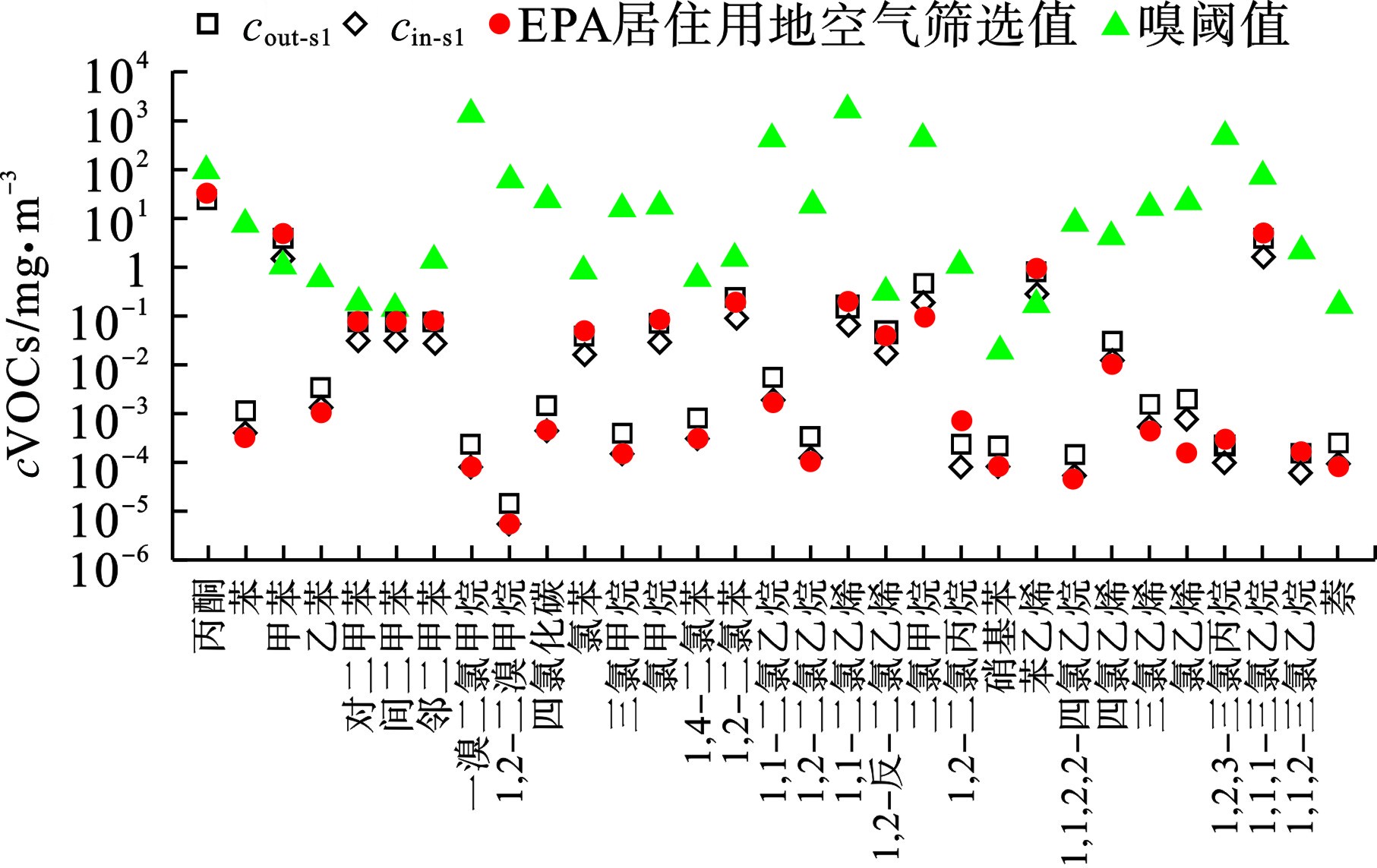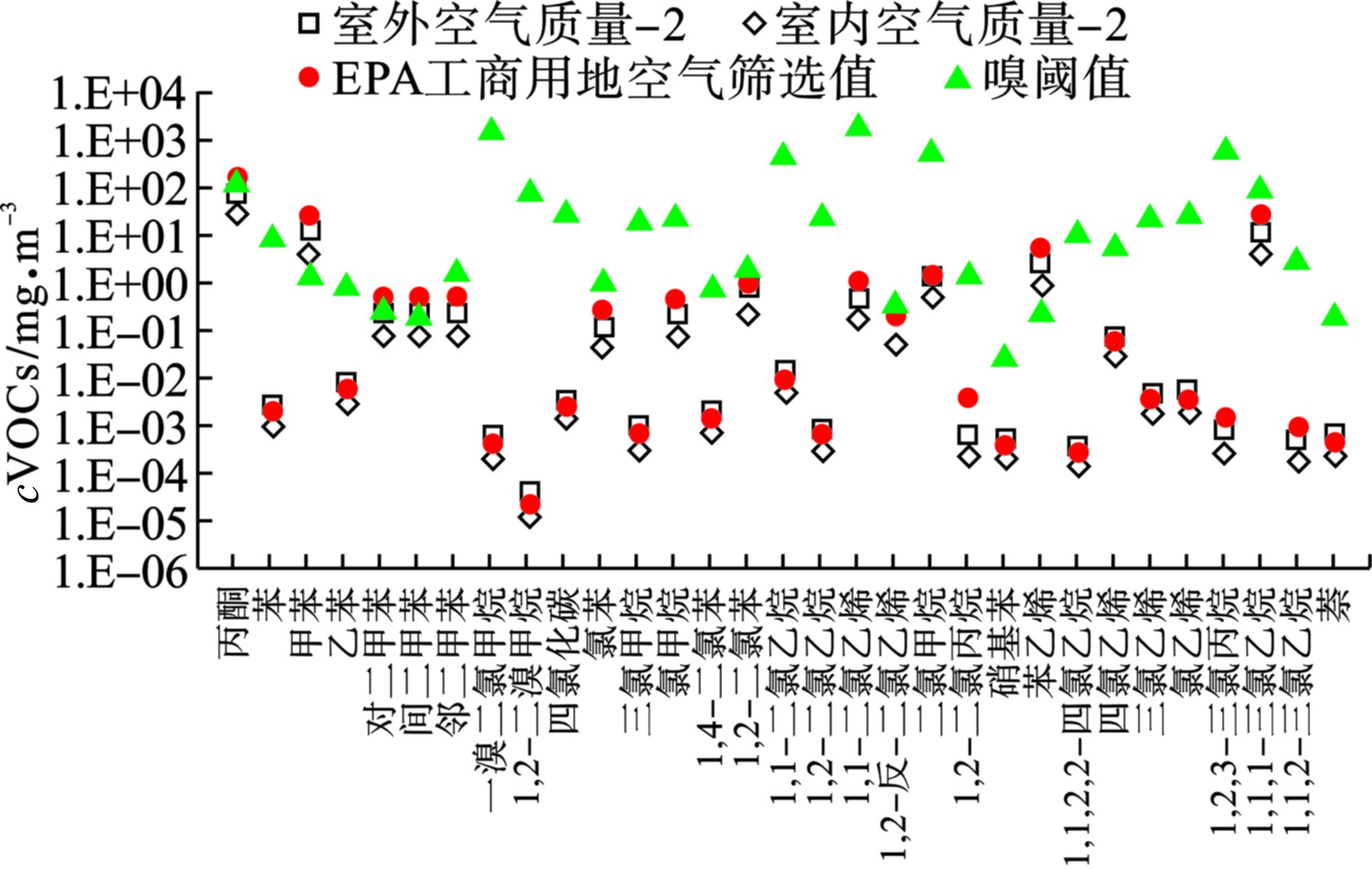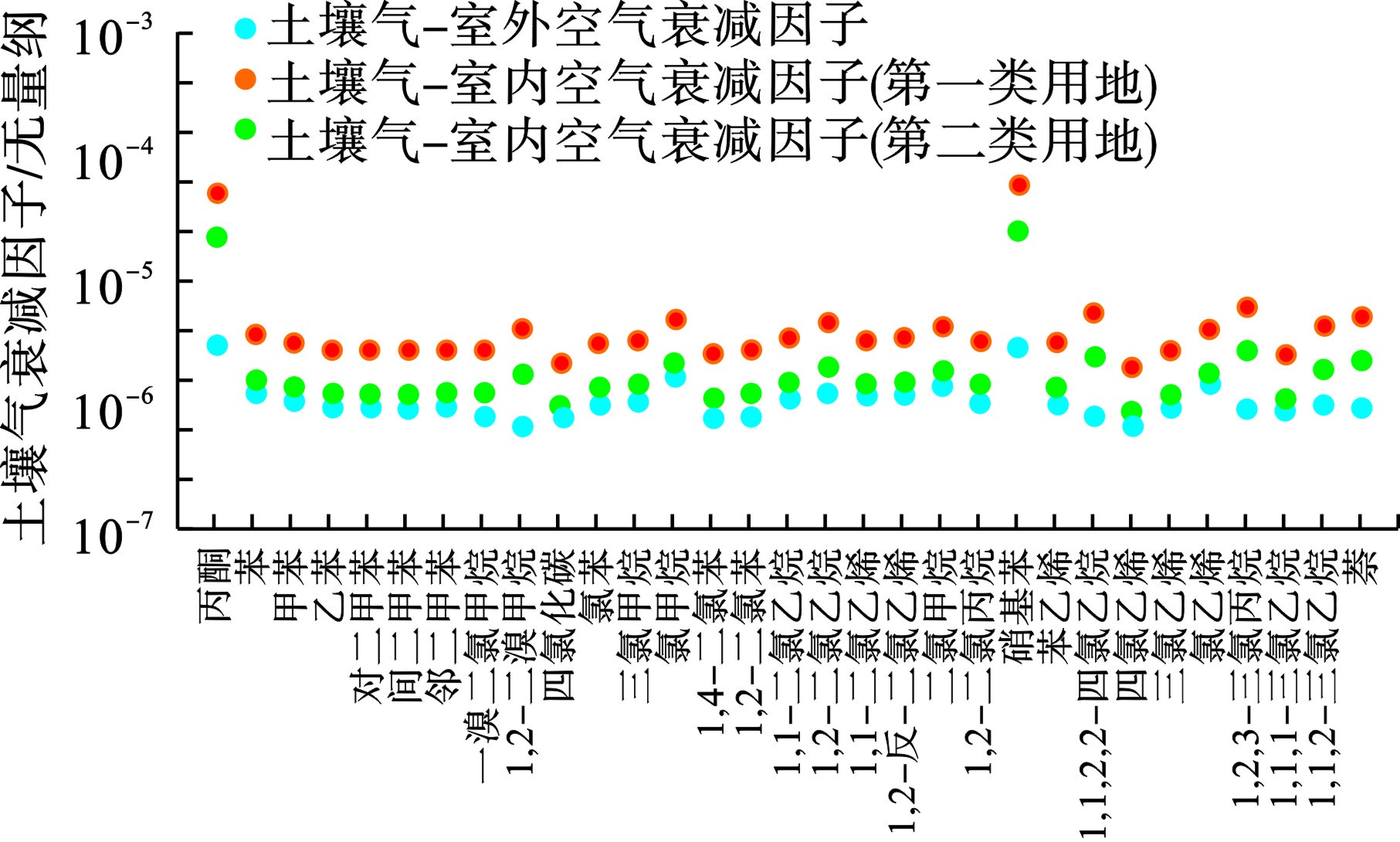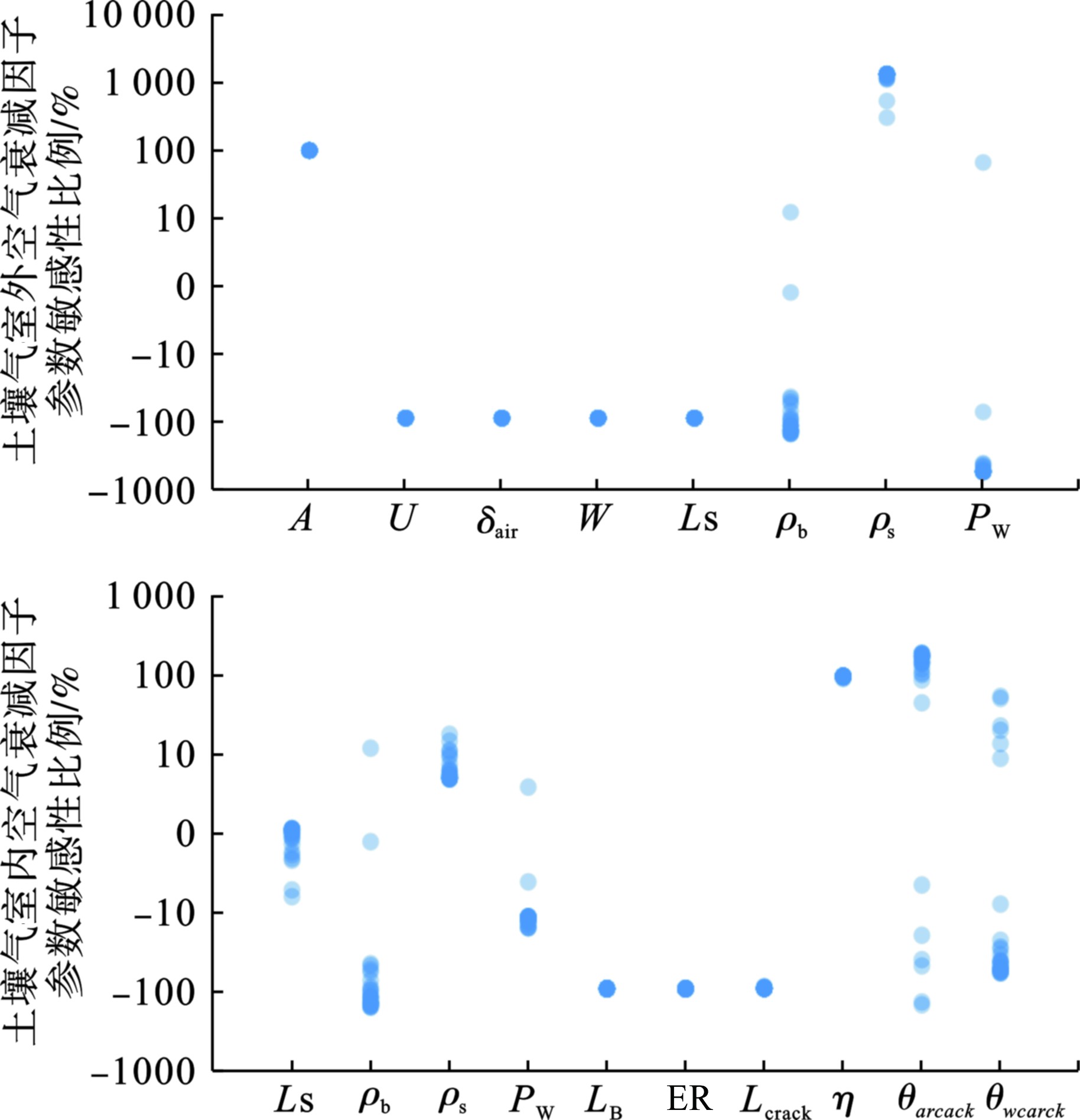-
挥发性有机污染物(volatile organic compounds,VOCs)是污染地块中常见的污染物,以单一或复合污染形式存在,在超过50%的污染地块中成为超标污染物[1-2]。与重金属、半挥发性有机物等污染物相比,VOCs易挥发、易迁移、且有异味[3-4],导致其调查、评估、修复与风险管控的技术难度均更大,成为污染地块研究和管理的难点和重点。《土壤环境质量建设用地土壤污染风险管控标准(试行):GB 36600—2018》[5]规定的45个基本项目中有27种为VOCs,许多国家也专门针对污染地块VOCs制定了调查评估与风险控制技术指南或导则[6]。
对于VOCs来说,自土壤中挥发进入室内空气(有建筑物情景)[7-8]、室外空气(绿地情景)[9]并产生的呼吸暴露途径是最主要的人体暴露途径;而前者又称“蒸气入侵”,被广泛关注和研究[10-12]。我国污染地块风险评估导则中推荐J&E模型(以下简称“导则模型”)对VOCs从土壤中挥发至土壤气、土壤气迁移、在暴露点混合等过程进行模拟[13],但也存在不确定性。如导则模型在计算VOCs在土壤水、气和固三相间的分配中偏向保守,且忽略了VOCs向上迁移发生的吸附、生物降解等作用,导致模型预测值与实测值存在较大差异,因而研究者推荐采用DED模型、增加生物降解模型或直接测定土壤气的方式开展土壤VOCs的风险评估[14-18]。另一方面,除了2015年北京市发布了15种VOCs的土壤气筛选值外[19],我国尚无全面的污染地块土壤气VOCs筛选值标准;且基于污染地块人体健康风险评估得到的空气允许值、土壤气VOCs筛选值与我国现行室内外环境空气质量标准、VOCs异味控制标准及嗅阈值均不接轨,我国污染地块VOCs的风险评估技术体系尚有较大完善空间[20]。
文章基于导则模型,推导不同用地情景下风险可接受阈值对应的空气VOCs允许浓度、土壤气衰减因子及土壤气VOCs筛选值,并与我国空气质量标准、EPA相关筛选值、嗅阈值进行比较,以期对完善我国污染地块土壤VOCs风险评估技术体系提供参考。
-
本研究的研究对象为《土壤环境质量建设用地土壤污染风险管控标准(试行):GB 36600—2018》[5]及《建设用地土壤污染风险评估技术导则:HJ 25.3—2019》[13]涉及的且可获得嗅阈值的污染地块常见VOCs,共计31种,见表1。VOCs嗅阈值来自日本环境卫生中心相关研究[21]及美国国家卫生研究院PubChem数据库[22],EPA居住用地和工商用地空气筛选值来自EPA区域筛选值[23]。
-
土壤中VOCs迁移至室内空气存在以下几个过程:(1)VOCs通过线性相分配从土壤或地下水中进入土壤空隙,即形成土壤气;(2)VOCs在包气带中通过向上扩散至建筑物底板;(3)VOCs通过扩散或对流通过建筑物地板裂隙等进入室内空间;(4)与室内空气混合。类似的,土壤中VOCs迁移至室外空气存在以下几个过程:(1)VOCs通过线性相分配从土壤或地下水中进入土壤空隙,即形成土壤气;(2)VOCs在包气带中通过向上扩散至近地表;(3)VOCs与室外空气混合。
根据导则模型[13],土壤VOCs迁移至室外或室内环境引起的人体健康风险用如下公式表示,各参数含义见表2。
-
吸入下层土壤VOCs迁移至室外引起的第一类用地(居住用地)情景下致癌风险
${{R}_{{\text{cout1}}}}$ 、第一类用地情景下非致癌风险${{R}_{{\text{ncout1}}}}$ 、第二类用地(工业用地)情景下致癌风险${{R}_{{\text{cout2}}}}$ 、第二类用地非致癌风险${{R}_{{\text{ncout2}}}}$ ,见式(1~4):式中:
$ {c_{{\text{out}}}} $ 为室外暴露点空气中VOCs浓度,mg·m−3;${{\rm{SF}}_{\text{\rm}{i}}}$ 为VOCs呼吸吸入致癌斜率因子,(kg·d)/mg−1;$ {{\rm{RfD}}_{i}} $ 为VOCs呼吸吸入参考剂量,mg/(kg·d)。 -
吸入下层土壤VOCs迁移至室内引起的第一类用地(居住用地)情景下致癌风险
${{R}_{{\text{cin1}}}}$ 、第一类用地情景下非致癌风险${{R}_{{\text{ncin1}}}}$ 、第二类用地(工业用地)情景下致癌风险${{R}_{{\text{cin2}}}}$ 、第二类用地非致癌风险${{R}_{{\text{ncin2}}}}$ ,见式(5~8):式中,
$ {c_{{\text{in}}}} $ 为室内暴露点空气中VOCs浓度,mg/m3。当单一暴露途径下,通过式(1~8)计算致癌风险达到10−6或非致癌风险(危害商)达到1时的室内外空气VOCs浓度,选取较小者作为室内外空气VOCs的允许浓度,分别记为
$ {c_{{\text{out - s1}}}} $ 、$ {c_{{\text{out - s2}}}} $ 、$ {c_{{\text{in - s1}}}} $ 和$ {c_{{\text{in - s2}}}} $ ,分别表示第一类用地情景下室外空气、第二类用地情景下室外空气、第一类用地情景下室内空气、第二类用地情景下室内空气的允许浓度,mg/m3。 -
土壤气VOCs浓度与室外、室内暴露点空气VOCs浓度的关系,见式(9~10):
式中:
$ {c_{{\text{sg}}}} $ 为土壤气中VOCs浓度,mg/m3;${{\rm{VF}}_{{\text{out}}}}$ 、${{\rm{VF}}_{{\text{in}}}}$ 分别为VOCs从土壤气至室外空气、室内空气的衰减因子,无量纲。根据文献[13],
${{\rm{VF}}_{{\text{out}}}}$ 、${{\rm{VF}}_{{\text{in}}}}$ ,见式(11~19):式中:
$ D_{\text{s}}^{{\text{eff}}} $ 和$ D_{{\text{crack}}}^{{\text{eff}}} $ 分别为土壤中、地基裂隙中气态污染物的有效扩散系数,cm2/s;$ {D_{\text{a}}} $ 和$ {D_{\text{w}}} $ 分别为污染物在空气中、水中的扩散系数,cm2/s;$ H' $ 为无量纲亨利常数;$ \theta $ 、$ {\theta _{{\text{as}}}} $ 和$ {\theta _{{\text{ws}}}} $ 分别为非饱和土层土壤中总孔隙体积比、孔隙水体积比和空气体积比,无量纲;$ {\rho _{\text{w}}} $ 为水密度(1 g/cm3);${{\rm{DF}}_{{\text{oa}}}}$ 、${{\rm{DF}}_{{\text{ia}}}}$ 为中间变量;其他参数含义见表2。 -
不同情景下的土壤气筛选值,见式(20~23):
式中:
${c_{{\text{sg-out-s1}}}}$ 、${c_{{\text{sg-out-s2}}}}$ 、${c_{{\text{sg-in-s1}}}}$ 、${c_{{\text{sg-in-s2}}}}$ 分别为第一类用地情景下室外空气、第二类用地情景下室外空气、第一类用地情景下室内空气、第二类用地情景下室内空气达到允许浓度时对应的土壤气筛选值,mg/m3,${{\rm{VF}}_{{\text{out-s1}}}}$ 、${{\rm{VF}}_{{\text{out-s2}}}}$ 、${{\rm{VF}}_{{\text{in-s1}}}}$ 和${{\rm{VF}}_{{\text{in-s2}}}}$ 分别为第一类用地(下标为s1)、第二类用地(下标为s2)情景下土壤气-室外空气(下标为out)和土壤气-室内空气(下标为in)衰减因子。 -
根据文献[13],主要模型参数及其取值见表2。1,2-二氯苯的理化参数、毒性参数来自文献[24],其他污染物的理化参数、毒性参数来自文献[13]。
-
不同用地情景下、不同参数对于土壤气衰减因子(
$ V{F_{{\text{out}}}} $ 、$ V{F_{{\text{in}}}} $ )的影响采用参数的敏感性比例(SR)表征,见式(24):式中:
$ {X_1} $ 为按表2计算得到的土壤气衰减因子,$ {X_2} $ 为某一参数提高10%后计算得到的衰减因子。 -
本研究计算和制图均采用Microsoft Excel 2019(OEM版)。
-
第一类用地和第二类用地情景下,VOCs呼吸暴露产生的人体健康风险达到可接受阈值(致癌风险10−6或者危害熵为1)时,计算得到的室内、室外空气允许浓度,见图1和图2。31种VOCs的
${c_{{\text{out-s1}}}}$ 、${c_{{\text{in-s1}}}}$ 、${c_{{\text{out-s2}}}}$ 和${c_{{\text{in-s2}}}}$ 分别为1.6×10−5~25、5.2×10−6~8.5 、2.9×10−5~60 和9.8×10−6~20 mg/m3。不同VOCs允许浓度不同主要原因是毒性不同。 -
基于导则模型计算得到的VOCs土壤气衰减因子见图3。由于参数取值一致,第一类用地和第二类用地情景下
${{\rm{VF}}_{{\text{out}}}}$ 一致,31种VOCs的衰减因子为6.4×10−7~2.9×10−6;${{\rm{VF}}_{{\text{in - s1}}}}$ 为1.9×10−6~5.6×10−5,${{\rm{VF}}_{{\text{in - s2}}}}$ 为8.4×10−7~2.4×10−5。对于同一种污染物,${{\rm{VF}}_{{\text{out}}}}$ <${{\rm{VF}}_{{\text{in - s2}}}}$ <${{\rm{VF}}_{{\text{in - s1}}}}$ 。根据空气允许浓度、导则模型推导的土壤气衰减因子,计算不同用地类型蒸气入侵情景下土壤气筛选值、并与EPA土壤气筛选值、VOCs嗅阈值进行比较,见图4。其中美国EPA土壤气筛选值为区域筛选值列出的室内空气筛选值除以美国EPA推荐的衰减因子0.03得到。31种VOCs的
${c_{{\text{sg-in-s1}}}}$ 和${c_{{\text{sg-in-s2}}}}$ 范围分别为1.3~5.7×105 和5.8~3.0×106 mg/m3。由于前述土壤气衰减因子的差异,基于导则模型推导的土壤气筛选值较EPA土壤气筛选值高约3~4个数量级。与VOCs嗅阈值相比,27种VOCs的${c_{{\text{sg-in-s1}}}}$ 超过嗅阈值、28种VOCs的${c_{{\text{sg-in-s2}}}}$ 超过嗅阈值,而仅有10种EPA土壤气筛选值超过对应嗅阈值。当仅仅考虑VOCs土壤进入室外空气产生的人体健康风险时,得到的土壤气筛选值更高,${c_{{\text{sg-out-s1}}}}$ 和${c_{{\text{sg-out-s2}}}}$ 的范围分别为24~8.7×106和46~2.0×107 mg/m3,见图5。 -
${{\rm{VF}}_{{\text{out}}}}$ 、${{\rm{VF}}_{{\text{in}}}}$ 的参数敏感性分析结果,见图6。由式(11)和(18)可知,${{{\rm{VF}}}_{{\text{out}}}}$ 与A成正比、与U、δair、W、Ls成反比,因此上述指标的敏感性比例为100%和−100%。ρb、ρs、Pw影响$ D_{\text{s}}^{{\text{eff}}} $ ,且不同VOCs的影响不同,总体上ρb或Pw升高、${{{\rm{VF}}}_{{\text{out}}}}$ 降低,ρs升高、${{{\rm{VF}}}_{{\text{out}}}}$ 升高。ρb、ρs、Pw敏感性比例中位数分别为−120%、1338%、−557%(31种VOCs),见表3。可见ρs、Pw对于${{{\rm{VF}}}_{{\text{out}}}}$ 是非常敏感的参数。对于${{{\rm{VF}}}_{{\text{in}}}}$ 来说,Ls、ρs、Pw的敏感性比例绝对值小于20%,是敏感性较小的参数;LB、ER、Lcrack敏感性比例约-90%,η的敏感性比例约90%,且这4个参数不同VOCs的敏感性接近;ρb、θacrack、θwcarck的敏感性比例对于不同的VOCs不同,中位数分别为-120%、152%、−43%,见表4。 -
本研究计算得到的
${c_{{\text{in-s1}}}}$ 、${c_{{\text{in-s2}}}}$ 与美国EPA区域筛选值所列的居住用地、工业用地空气筛选值总体接近。主要因为我国风险评估模型与美国RBCA模型相近,部分参数取值略有不同,从而导致结果差别不大[25]。与我国大气中VOCs浓度及相关标准比较,计算得到的允许浓度偏于严格。苯的${c_{{\text{in-s1}}}}$ 为0.4 μg/m3,远小于《室内空气质量标准:GB/T 18883—2002)》的110 μg/m3,也小于2020年修订版(征求意见稿)的30 μg/m3。赵文静等[26]收集了全国各类场景464个室内苯浓度,统计发现几何均值为30 μg/m3,并基于致癌风险10−4的阈值推导室内苯限值为20 μg/m3;肖龙等[27]报道了4个国家级大气环境监测背景站夏季环境空气中苯的浓度为0.4~3 μg/m3。可见基于导则模型推导出的苯的室内空气允许浓度较为保守。二甲苯、三氯乙烯和四氯乙烯的${c_{{\text{in-s1}}}}$ 分别为27.6、0.6 和11 μg/m3,也均远小于《室内空气质量标准》2020年修订版(征求意见稿)的200、6和120 μg/m3。31种VOCs中,16种的${c_{{\text{in-s1}}}}$ <1 μg/m3,低于环境空气检测常规方法(采样量2 m3)的测定下限(1.2~4.0 μg/m3)[28]。甲苯与上述VOCs的规律不同,${c_{{\text{in-s1}}}}$ 为1.4 mg/m3,高于《室内空气质量标准:GB/T 18883—2002》规定的0.2 mg/m3;原因是甲苯毒性相对较小,导致以模型推导出的允许浓度较大。不同标准采用的风险评估模型、主要参数、可接受阈值不同,造成不同标准对于同一种物质限值不同。此外,对比表1中VOCs的嗅阈值,31种VOCs中除了甲苯和苯乙烯外,其他29种VOCs的
${c_{{\text{out-s1}}}}$ 、${c_{{\text{in-s1}}}}$ 、${c_{{\text{out-s2}}}}$ 和${c_{{\text{in-s2}}}}$ 均低于对应的嗅阈值,表明根据导则模型开展风险评估时,若上述29种VOCs的土壤风险可接受时,在下层土壤中挥发出的VOCs不会造成异味扰民问题。需要注意的是甲苯和苯乙烯,由于毒性较低,模型反算推导出的允许浓度较大;若以基于导则计算的空气允许浓度确定的土壤限值为修复目标时,可能引发异味问题。实际上,《土壤环境质量建设用地土壤污染风险管控标准(试行):GB 36600—2018》确定甲苯和苯乙烯的筛选值和管制值时,也不是基于风险评估模型计算确定的,而是采用了这两种VOCs的土壤饱和浓度作为“封顶值”[24,29]。 -
由于捕捉VOCs污染区域能力更强、更准确反映VOCs扩散过程的呼吸暴露风险,土壤气监测在VOCs污染地块调查和评估中逐渐得到重视和应用[17],但对于土壤气结果的使用与评价我国尚无相关技术规定。
美国的土壤气筛选值使用基于风险评估的室内VOCs允许浓度及土壤气衰减因子的经验数值计算得到。其原因为美国污染地块的风险评估对象多为现状居住的居民[30],可以通过实测建立土壤气—室内空气VOCs的关系;且美国建筑形式与底板结构与我国存在较大差别,更利于VOCs进入室内空间,因而实测得到的土壤气衰减因子相对更大。美国EPA构建了污染地块VOCs蒸气入侵监测数据库,统计结果表明,431组底板下(sub-slab)土壤气衰减因子最小值为2.5×10−5、中位数为2.7×10−3、95%分位数为2.6×10−2,106组建筑物周边土壤气衰减因子最小值为5×10−6、中位数为3.8×10−3、95%分位数为0.25。据此EPA推荐将0.03作为蒸气入侵风险评估筛选时初步土壤气的衰减因子[31],较本研究得到的衰减因子高3~4个数量级。
我国污染地块的开发模式决定了风险评估主要是依靠模型预测未来潜在的风险,通过概化的模型及相对保守的参数计算潜在的暴露量及风险水平。钟茂生等[32]通过模型计算了苯、甲苯、氯仿、1,1-二氯乙烯的土壤气-室内空气衰减因子,居住用地、工商用地下分别为3.1×10−4~3.7×10−4和1.3×10−4~1.5×10−4;本研究推导的上述VOCs的
$ V{F_\text{in-s1}} $ 、$ V{F_\text{in-s2}} $ 分别为3.0×10−6~3.5×10−6和1.3×10−6~1.5×10−6低于上述研究2个数量级。上述差异的原因在于两个研究采用的$ \theta $ 、$ {\theta _\text{as}} $ 、$ {\theta _\text{ws}} $ 、$ {\theta _\text{acrack}} $ 、$ {\theta _\text{wcrack}} $ 和$ {L_\text{crack}} $ 等关键参数的取值不同。《土壤环境质量建设用地土壤污染风险管控标准(试行):GB 36600—2018》编制时,在《污染地块土壤风险评估导则:HJ 25.3—2014》的基础上进行了部分修改,其中包括影响VOCs迁移扩散的部分参数,如Pw从0.1调为0.2、Lcrack从15调为35 cm,η从0.01调为0.0005[24],并写入了修订后的HJ 25.3—2019中[13]。这些参数变化使VOCs的土壤风险筛选值提高了1个数量级,如苯从0.064提至1 mg/kg(第一类用地筛选值,下同)、1,2-二氯乙烷从0.019提至0.52 mg/kg、三氯甲烷从0.022提至0.3 mg/kg[5,33],避免了筛选值低于当时检测方法检出限的问题,并在一定程度上避免了过度修复。但由本研究结果可知,正是由于这些敏感性比例较大的关键参数的变化,使模型计算的土壤气衰减因子大幅降低。由于导则推算的室内空气允许浓度与EPA基本相近,而筛选因子低于EPA 3~4个数量级,导致计算推导的土壤气筛选值远远高于EPA筛选值甚至嗅阈值。 -
污染地块VOCs在较低浓度下就可能形成恶臭污染[34],科学合理制定污染地块VOCs修复目标、土壤气筛选标准对于污染地块修复过程二次污染控制及未来再开发利用非常重要。本研究结果表明导则模型在暴露点VOCs浓度的允许限值上较为保守,部分VOCs允许浓度低于《室内空气质量标准》、甚至检测方法测定下限。但导则模型在土壤气-室内空气衰减因子的模拟方面则不够保守,模型计算的衰减因子低于EPA经验数值3~4个数量级;这使得土壤气浓度较高、明显存在异味时,通过模型计算得到的室内、室外呼吸暴露风险可能仍然可接受。因此,制定土壤气筛选值时或通过土壤气监测结果开展风险评估时,建议充分考虑模型计算的不确定性,加强我国土壤气-室内空气关系的实测研究,并基于嗅阈值进行调整修正。
-
本研究基于导则模型,推导了不同用地情景下污染地块VOCs室内外空气允许浓度、土壤气衰减因子及土壤气筛选值,得到如下结论。
(1)第一类用地和第二类用地情景下,呼吸暴露产生的人体健康风险达到可接受阈值时,计算得到31种VOCs室内、室外空气允许浓度分别为1.6×10−5~25和5.2×10−6~8.5 mg/m3(第一类用地),2.9×10−5~60 和9.8×10−6~20 mg/m3(第二类用地),除甲苯和苯乙烯外,其他VOCs空气允许浓度低于嗅阈值,部分VOCs室内空气允许浓度远低于室内空气质量标准。
(2)31种VOCs的土壤气-室内空气衰减因子为1.9×10−6~5.6×10−5(第一类用地)和8.4×10−7~2.4×10−5(第二类用地),低于美国EPA推荐值3~4个数量级;影响土壤气衰减因子计算的敏感参数包括气象参数、污染源尺寸参数、土壤理化性质、建筑底板参数。
(3)基于导则模型推导31种VOCs基于蒸气入侵的土壤气筛选值分别为1.3~5.7×105 (第一类用地)和5.8~3.0×106 mg/m3(第二类用地),较美国EPA土壤气筛选值高约3~4个数量级,大多数土壤气筛选值高于嗅阈值。
(4)导则模型在暴露点浓度的允许限值上较为保守,但在土壤气-室内空气的衰减模拟方面不够保守,因而在制定土壤气筛选值时或通过土壤气监测结果开展风险评估时,建议充分考虑模型计算的不确定性,并基于嗅阈值进行调整修正。
基于导则模型计算的污染地块挥发性有机物空气、土壤气限值研究
Study on acceptable levels of volatile organic compounds in air and soil gas in contaminated sites based on Guideline model
-
摘要: 我国主要采用风险评估导则模型模拟VOCs在污染地块土壤中的扩散迁移和进入室内外暴露点,系统分析模型预测扩散后的气体浓度鲜有研究。文章基于导则模型,研究了31种VOCs的空气允许浓度及对应的土壤气限值。模型计算结果表明,呼吸暴露产生的人体健康风险达到可接受阈值时,VOCs室内空气允许浓度为1.6×10−5~25 (居住用地)和2.9×10−5~60 mg/m3(工业用地),部分VOCs室内空气允许浓度远低于室内空气质量标准。VOCs的土壤气-室内空气衰减因子为1.9×10−6~5.6×10−5(居住用地)和8.4×10−7~2.4×10−5(工业用地),低于美国国家环境保护局(US Environmental Protection Agency,EPA)推荐值3~4个数量级;31种VOCs基于蒸气入侵的土壤气筛选值分别为1.3~5.7×105 (居住用地)和5.8~3.0×106 mg/m3(工业用地),较EPA土壤气筛选值高约3~4个数量级,大多数土壤气筛选值高于嗅阈值。研究结果可为VOCs污染地块土壤气筛选值的制定和使用提供参考。Abstract: The diffusion and migration of volatile organic compounds (VOCs) in contaminated soil into indoor and outdoor exposure points were mostly simulated by the models recommended by the Risk Assessment Guideline of Contaminated Sites. However, few studies systematically analyzed the gas concentration predicted by the model. This study calculated the acceptable air concentrations of 31 VOCs and their corresponding screening levels for soil gas. The results showed the corresponding acceptable indoor air concentrations (AIACs) of VOCs were 1.6×10−5~25 mg/m3 under residential land use scenarios, and 2.9×10−5~60 mg/m3 under industrial land use scenarios. The AIACs of some VOCs were much lower than the Indoor Air Quality Standard. The soil gas to indoor air attenuation factors for the 31 VOCs were 1.9×10−6~5.6×10−5 (residential land use), and 8.4×10−7~2.4×10−5 (industrial land use), which were 3~4 orders of magnitude lower than the values recommended by the US EPA. The screening levels of soil gas considering vapor intrusion were 1.3~5.7×105 mg/m3 (residential land use) and 5.8~3.0×106 mg/m3 (industrial land use), which were 3~4 orders of magnitude higher than the US EPA’s screening levels. Besides, most of the soil gas screening values derived by the models were over the odor thresholds of the corresponding VOCs. The results of this research could provide a reference for the derivation of soil gas screening levels and handling of soil gas testing results in VOCs-contaminated sites.
-

-
表 1 本研究选取的VOCs
Table 1. VOCs selected in the study
序号 中文名 CAS 编号 美国EPA居住用地空
气筛选值/mg·m−3美国EPA工商用地空
气筛选值/mg·m−3嗅阈值#/mg·m−3 1 丙酮 67-64-1 3.2×101 1.4×102 1.2×102 † 2 苯 71-43-2 3.6×10−4 1.6×10−3 8.6 † 3 甲苯 108-88-3 5.2 2.2×101 1.2 † 4 乙苯 100-41-4 1.1×10−3 4.9×10−3 7.4×10−1 † 5 对二甲苯 106-42-3 1.0×10−1 4.4×10−1 2.5×10−1 † 6 间二甲苯 108-38-3 1.0×10−1 4.4×10−1 1.8×10−1 † 7 邻二甲苯 95-47-6 1.0×10−1 4.4×10−1 1.6 † 8 一溴二氯甲烷 75-27-4 7.6×10−5 3.3×10−4 1.7×103 ‡ 9 1,2-二溴甲烷 106-93-4 4.7×10−6 2.0×10−5 7.7×101 ‡ 10 四氯化碳 56-23-5 4.7×10−4 2.0×10−3 2.9×101 † 11 氯苯 108-90-7 5.2×10−2 2.2×10−1 9.8×10−1 ‡ 12 三氯甲烷 67-66-3 1.2×10−4 5.3×10−4 1.9×101 † 13 氯甲烷 74-87-3 9.4×10−2 3.9×10−1 2.1×101 ‡ 14 1,4-二氯苯 106-46-7 2.6×10−4 1.1×10−3 7.2×10−1 ‡ 15 1,2-二氯苯 95-50-1 2.1×10−1 8.8×10−1 1.8 ‡ 16 1,1-二氯乙烷 75-34-3 1.8×10−3 7.7×10−3 4.8×102 ‡ 17 1,2-二氯乙烷 107-06-2 1.1×10−4 4.7×10−4 2.4×101 ‡ 18 1,1-二氯乙烯 75-35-4 2.1×10−1 8.8×10−1 2.0×103 ‡ 19 1,2-反式-二氯乙烯 156-60-5 4.2×10−2 1.8×10−1 3.4×10−1 ‡ 20 二氯甲烷 75-09-2 1.0×10−1 1.2 5.6×102 † 21 1,2-二氯丙烷 78-87-5 7.6×10−4 3.3×10−3 1.3 ‡ 22 硝基苯 98-95-3 7.0×10−5 3.1×10−4 2.4×10−2 ‡ 23 苯乙烯 100-42-5 1.0 4.4 2.1×10−1 ‡ 24 1,1,2,2-四氯乙烷 79-34-5 4.8×10−5 2.1×10−4 1.0×101 ‡ 25 四氯乙烯 127-18-4 1.1×10−2 4.7×10−2 5.2 † 26 三氯乙烯 79-01-6 4.8×10−4 3.0×10−3 2.1×101 † 27 氯乙烯 75-01-4 1.7×10−4 2.8×10−3 2.6×101 ‡ 28 1,2,3-三氯丙烷 96-18-4 3.1×10−4 1.3×10−3 6.0×102 ‡ 29 1,1,1-三氯乙烷 71-55-6 5.2 2.2×101 8.7×101 ‡ 30 1,1,2-三氯乙烷 79-00-5 1.8×10−4 7.7×10−4 2.7 ‡ 31 萘 91-20-3 8.3×10−5 3.6×10−4 2.0×10−1 ‡ 注:† ,嗅阈值来自文献[21];‡,嗅阈值来自文献[22];# ,嗅阈值换算:嗅阈值(mg·m−3)=嗅阈值(ppm)×分子量/24.5。 表 2 模型参数
Table 2. Model parameters
参数符号 参数名称 单位 第一类用地取值 第二类用地取值 Ls 下层污染土壤层埋深 cm 50 50 A 污染源区面积 cm2 16000000 16000000 ρb 土壤容重 g·cm−3 1.5 1.5 Pw 土壤含水率 g·g−1 0.2 0.2 ρs 土壤颗粒密度 g·cm-3 2.65 2.65 Uair 混合区大气流速风速 cm·s−1 200 200 δair 混合区高度 cm 200 200 W 污染源区宽度 cm 4000 4000 r 地基裂隙中空气体积比 无量纲 0.26 0.26 θwcarck 地基裂隙中水体积比 无量纲 0.12 0.12 Lcrack 室内地基厚度 cm 35 35 LB 室内空间体积与气态污染物入渗面积之比 cm 220 300 ER 室内空气交换速率 次·d−1 12 20 η 地基和墙体裂隙表面积所占比例 无量纲 0.0005 0.0005 EDa 成人暴露期 a 24 25 EDc 儿童暴露期 a 6 - EFIa 成人室内暴露频率 d·a−1 262.5 187.5 EFIc 儿童室内暴露频率 d·a−1 262.5 - EFOa 成人室外暴露频率 d·a−1 87.5 62.5 EFOc 儿童室外暴露频率 d·a−1 87.5 - BWa 成人平均体重 kg 61.8 61.8 BWc 儿童平均体重 kg 19.2 — DAIRa 成人每日空气呼吸量 m3·d−1 14.5 14.5 DAIRc 儿童每日空气呼吸量 m3·d−1 7.5 - SAF 暴露于土壤的参考剂量分配比例 无量纲 0.33 0.33 ATca 致癌效应平均时间 d 27740 27740 ATnc 非致癌效应平均时间 d 2190 9125 表 3 31种VOCs土壤气-室外空气衰减因子参数敏感性比例统计
Table 3. Sensitivity ratio of soil air-outdoor air attenuation factors to 31 VOCs
% 衰减因子 最小值 25%分位数 中位数 75%分位数 最大值 A 100 100 100 100 100 U −91 −91 −91 −91 −91 δair −91 −91 −91 −91 −91 W −91 −91 −91 −91 −91 Ls −91 −91 −91 −91 −91 ρb −156 −142 −120 −87 12 ρs 307 1301 1338 1351 1357 Pw −569 −565 −557 −535 66 表 4 31种VOCs土壤气-室内空气衰减因子参数敏感性比例统计
Table 4. Sensitivity ratio of soil air-indoor air attenuation factors to 31 VOCs
% 衰减因子 最小值 25%分位数 中位数 75%分位数 最大值 Ls −6 −1 −1 −1 −1 ρb −156 −142 −120 −87 12 ρs 5 5 6 7 18 Pw −16 −13 −12 −11 4 LB −91 −91 −91 −91 −91 ER −91 −91 −91 −91 −91 Lcrack −90 −90 −90 −90 −86 η 93 99 99 99 99 θacrack −145 89 152 180 195 θwcarck −58 −53 −43 −22 55 -
[1] 葛锋, 张转霞, 扶恒, 等. 我国有机污染场地现状分析及展望[J]. 土壤, 2021, 53(6): 1132 − 1141. doi: 10.13758/j.cnki.tr.2021.06.005 [2] 张文毓, 姜林, 钟茂生, 等. 挥发性有机物污染场地修复与风险控制技术[J]. 环境保护, 2021, 49(20): 27 − 33. doi: 10.14026/j.cnki.0253-9705.2021.20.010 [3] 张施阳, 李青青, 杨洁. 挥发性有机污染土壤开挖异味风险评估及控制对策 [J/OL].[2022-07-2] 环境科学研究, DOI:10.13198/j.issn.1001-6929.2022.05.03. [4] 马妍, 郑红光, 史怡, 等. 典型农药污染地块土壤中异味物质的筛查与分布特征研究[J]. 环境科学研究, 2022, 35(6): 1482 − 1489. doi: 10.13198/j.issn.1001-6929.2022.02.05 [5] 国家生态环境部, 国家市场监督管理总局. 土壤环境质量建设用地土壤污染风险管控标准(试行): GB 36600-2018 [S/OL].[2018-7-3]. https://www.mee.gov.cn/ywgz/fgbz/bz/bzwb/trhj/201807/t20180703_446027.shtml [6] 马杰. 污染场地VOCs蒸气入侵风险评估与管控 [M]. 北京: 科学出版社, 2020. [7] 苏燕, 程卫国, 李亚斌, 等. 场地土壤有机氯污染物暴露途径贡献率分析[J]. 环境保护科学, 2019, 45(4): 106 − 113. doi: 10.16803/j.cnki.issn.1004-6216.2019.04.020 [8] 马杰. 我国挥发性有机污染地块调查评估中存在的问题及对策建议[J]. 环境工程学报, 2021, 15(1): 3 − 7. doi: 10.12030/j.cjee.202007080 [9] 张丽娜, 姜林, 钟茂生, 等. 基于用地规划的大型污染场地健康风险评估[J]. 环境科学研究, 2015, 28(5): 788 − 795. doi: 10.13198/j.issn.1001-6929.2015.05.17 [10] MA J, MCHUGH T, BECKLEY L, et al. Vapor intrusion investigations and decision-making: A critical review[J]. Environmental Science & Technology, 2020, 54(12): 7050 − 7069. [11] MAN J, GUO Y, ZHOU Q, et al. Database examination, multivariate analysis, and machine learning: Predictions of vapor intrusion attenuation factors[J]. Ecotoxicology and Environmental Safety, 2022, 242(1): 113874. [12] UNNITHAN A, BEKELE D, CHADALAVADA S, et al. Insights into vapour intrusion phenomena: Current outlook and preferential pathway scenario[J]. Science of the Total Environment, 2021, 796(20): 148885. [13] 生态环境部. 建设用地土壤污染风险评估技术导则: HJ 25.3-2019 [S/OL].[2019-12-5]. [2019-12-5]. https://www.mee.gov.cn/ywgz/fgbz/bz/bzwb/trhj/201912/t20191224_749893.shtml. [2019-12-5]. [14] 张瑞环, 钟茂生, 姜林, 等. 基于DED模型的挥发性有机物健康风险评价[J]. 环境科学研究, 2018, 31(1): 170 − 178. doi: 10.13198/j.issn.1001-6929.2017.03.64 [15] MA J, JIANG J, LAHVIS M. Vapor intrusion management in China: Lessons learned from the United States[J]. Environmental Science & Technology, 2018, 52(6): 3338 − 3339. [16] VERGINELLI I, YAO Y. A review of recent vapor intrusion modeling work[J]. Groundwater Monitoring & Remediation, 2021, 41(7): 138 − 144. [17] 马杰. 土壤气监测在污染地块调查评估中的优势、局限及解决思路[J]. 环境工程学报, 2021, 15(8): 2531 − 2535. doi: 10.12030/j.cjee.202011091 [18] 崇哲萍, 王月, 尧一骏. Johnson-Ettinger蒸气入侵风险评估模型参数修正研究[J]. 生态毒理学报, 2022, 17(1): 185 − 190. [19] 北京市市场监督管理局 污染场地挥发性有机物调查与风险评估技术导则: DB11/T 1278-2015 [S/OL]. http://bjtsbapi.hbjl.org.cn/file/2021/20210325/8789f1ee-6bc3-40f7-b4a9-8229f9236320.PDF.. [20] 姜林, 梁竞, 钟茂生, 等. 复杂污染场地的风险管理挑战及应对[J]. 环境科学研究, 2021, 34(2): 458 − 467. doi: 10.13198/j.issn.1001-6929.2020.07.14 [21] YOSHIO NAGATA. Measurement of odor threshold by triangle odor bag method odor [EB/OL].[2022-7-20]. https://www.env.go.jp/en/air/odor/measure/index.html. [22] National Institutes of Health. PubChem [DB/OL]. [2022-7-20].https://pubchem.ncbi.nlm.nih.gov/. [23] US EPA. Regional Screening Levels (RSLs) - Generic Tables [DB/OL].[2021-5-6]. https://www.epa.gov/risk/regional-screening-levels-rsls-generic-tables. [24] 生态环境部. 《土壤环境质量建设用地土壤污染风险管控标准(试行)(征求意见稿)》编制说明 [EB/OL]. https://www.mee.gov.cn/gkml/hbb/bgth/201801/t20180124_430241.htm. [2018-1-22]. [25] 王儒. RAG-C及RBCA模型在污染地块风险评估中的应用比较——以石油烃(C10~C40)的分段评估为例[J]. 环境保护科学, 2022, 48(3): 126 − 131. doi: 10.16803/j.cnki.issn.1004-6216.2022.03.020 [26] 赵文静, 马雪璞, 阿依博塔·吐尔逊别克, 等. 基于中国人群暴露风险的室内苯健康限值推导 [J/OL]. [2022-07-20].中国环境科学. DOI:10.19674/j.cnki.issn1000-6923.20220616.018. [27] 肖龙, 王帅, 周颖, 等. 中国典型背景站夏季VOCs污染特征及来源解析[J]. 中国环境科学, 2021, 41(5): 2014 − 2027. doi: 10.19674/j.cnki.issn1000-6923.2021.0212 [28] 环境保护部. 环境空气 挥发性有机物的测定 吸附管采样-热脱附/气相色谱-质谱法: HJ 644-2013 [S/OL]. https://www.mee.gov.cn/ywgz/fgbz/bz/bzwb/jcffbz/201302/t20130222_248384.shtml. [2013-2-17]. [29] US EPA. Regional Screening Levels (RSLs) - User's Guide [OL]. [2021-12-23]. https://www.epa.gov/risk/regional-screening-levels-rsls-users-guide. [30] 尧一骏. 我国污染场地治理与风险评估[J]. 环境保护, 2016, 44(20): 25 − 28. doi: 10.14026/j.cnki.0253-9705.2016.20.005 [31] US EPA. Technical Guide for Assessing and Mitigating the Vapor Intrusion Pathway from Subsurface Vapor Sources to Indoor Air [R/OL].[2015-06]. https://www.epa.gov/vaporintrusion/technical-guide-assessing-and-mitigating-vapor-intrusion-pathway-subsurface-vapor. [32] 钟茂生, 姜林, 贾晓洋, 等. 蒸气入侵暴露情景下土壤气筛选值推导与比较[J]. 环境科学研究, 2013, 26(9): 979 − 988. doi: 10.13198/j.issn.1001-6929.2013.09.010 [33] 环境保护部. 建设用地土壤污染风险筛选指导值(二次征求意见稿).[2015-8-22]. https://www.mee.gov.cn/gkml/hbb/bgth/201508/W020150821605911260736.pdf. [34] 张焱鑫, 孙佳薇, 席劲瑛, 等. 农药行业污染场地挥发性有机物释放能力及其评价方法研究[J]. 环境科学学报, 2022, 42(3): 450 − 456. doi: 10.13671/j.hjkxxb.2021.0345 -




 下载:
下载:




























































































